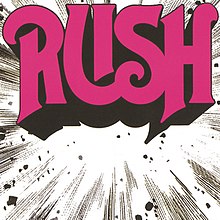Rush (Rush album)
| Rush | ||||
|---|---|---|---|---|
 |
||||
| Studio album by Rush | ||||
| Released | March 1, 1974 May 6, 1997 (Remastered CD) |
|||
| Recorded | Early 1973 - November 1973 | |||
| Studio | Eastern Sound Studios & Toronto Sound Studios, Toronto, Canada | |||
| Genre | ||||
| Length | 39:51 | |||
| Label | ||||
| Producer | Rush | |||
| Rush chronology | ||||
|
||||
| Singles from Rush | ||||
|
||||
| Professional ratings | |
|---|---|
| Review scores | |
| Source | Rating |
| AllMusic | |
| The Rolling Stone Album Guide | |
Rush is the debut studio album by Canadian rock band Rush, released on March 1, 1974 by the band's own label Moon Records in Canada and by Mercury Records in the United States and internationally. Their first release shows much of the hard rock sound typical of many of the popular rock bands emerging earlier in the decade. Rush were fans of such bands as Led Zeppelin and Cream, and these influences can be heard in most of the songs on this album.
Original drummer John Rutsey performed all drum parts on the album, but was unable to go on extended tours because of complications with his diabetes and was let go by the band after the album was released. Rutsey contributed to the album's lyrics, but never submitted the work to the other members of the band. The lyrics were instead entirely composed by Lee and Lifeson. Rutsey was soon replaced by Neil Peart, who has remained the band's drummer.
Originally the recording sessions were produced by Dave Stock at Eastern Sound Studios in Toronto. They were scheduled late at night during the 'dead' time in studios because of the band's low budget and the rates during this period were the cheapest. Stock had also worked on the band's debut single (a cover of Buddy Holly's "Not Fade Away", with an original composition, "You Can't Fight It", on the B-side). "You Can't Fight It" was to be included on the album but was scrapped. Two of the Eastern Sound recordings, "In the Mood" and "Take a Friend" were included on the final album.
However, Rush were unhappy with the quality of the first sessions. They moved to Toronto Sound Studios and produced the next sessions themselves while achieving a significant improvement in recording quality. They added new overdubs to existing backing tracks of "What You're Doing", "Before and After" and "Working Man". The tracks with the most advanced production were recorded entirely at Toronto Sound: "Finding My Way", "Need Some Love" and "Here Again". These new songs took the place of recordings from the earlier sessions. Both studios used 8-channel multitrack recorders, which was quite primitive for 1973, but the group quickly learned to make the best use of the technology that was available.
...
Wikipedia
